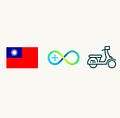Gogoro: electrifying Asia's scooters
The Taiwan-bred company, which IPO’d last year, is rethinking Asia's EV paradigm.
Regional preference
To the American reader, two-wheeler scooters might be reminiscent of their Italian honeymoon, when they rented Vespas to skirt around Rome’s ancient ruins. To the European reader, two-wheeler scooters might evoke their first vehicle, bought with their slim savings at the tender age of 18. Two-wheeler scooters don’t hold the same mysticism for the Asian reader however, as the scooter is simply a daily life necessity.
In India, two/three-wheelers outnumber cars by a factor of 4. The incessant, seemingly endless flow of scooters is what jumps to the untrained eye when watching a documentary about any Southeast Asian metropolis. Some rare rich Asian countries such as Japan and South Korea boast high car ownership levels but the rest, Southeast Asia in particular, are avid two-wheeler riders.
“More than eight-in-ten in Thailand, Vietnam, Indonesia, and Malaysia own a scooter. And the next tier of motorcycle owners are all in Asia: China at 60%, India at 47% and Pakistan at 43%.”
Pew Research
A vast majority of scooters in Southeast Asia today are so-called “ICE scooters”, short for “Internal Combustion Engine“. They use petrol and release CO2 from their exhaust pipes. The dense agglomeration of these scooters in Southeast Asia’s urban centers has unsurprisingly led to spikes in air pollution, notoriously nefarious for human health. Vehicle emissions are one of the main culprits in Jakarta’s sad crowning as the world’s most polluted capital city.




